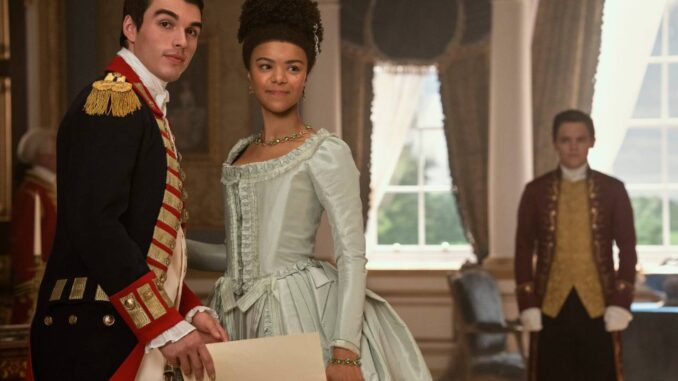
After the two previous relatively successful seasons, Netflix and Shondaland recently released a new season of the Bridgerton TV Series called Queen Charlotte. It was thought that the third season of the series would tell the story of Colin and Penelope continuing the previous one, but surprisingly this is a spin-off, following the life of Queen Charlotte.
Following the life of the above character, the film is a journey from when she was a princess in faraway Germany, to when she married King George III and then became Queen, taking responsibility for finding the next successor when the whole court fell into chaos.
While seasons 3 and 4 are still filming, focusing on a supporting character compared to the plot of the previous 2 Bridgerton seasons could be a completely smart calculation, when Shondaland needs to consider more in the new seasons, when the previous season received quite a few negative reviews.
The “Great Experiment” Between Two Skin Colors and Two Races?
Consisting of 6 episodes, Queen Charlotte has two parallel storylines, not following a linear pattern but intertwined to create a multi-meaningful and quite complex structure. Just a few days after its release, it climbed to the Top 1 Netflix globally with about 150 million hours of viewing upon its release. What makes this work successful?

First of all, it tells a story that is completely different from other works of the same genre. The fact that Queen Charlotte has dark skin is a recent controversy, but more importantly, the meaning and content that the film crew cleverly incorporates.
In this work, Queen Augusta (mother of King George III) as well as the royal court called the combination of two skin colors and two races the “Great Experiment”. They followed each step of the marriage, to evaluate whether a seemingly crazy idea would come true?
Not only in the two main characters, but the experiment also helped to give the nobility more diversity. In the ball, we can see an acknowledgement of both Asian and African descent. This is almost unimaginable, and it can be seen that Queen Charlotte is aiming for a greater meaning of unity, even though this is just a work of fiction.
Therefore, although it is not yet consistent with historical events, the film has still created quite a few positive impressions, attracting a large number of viewers. From skin color, ethnicity, gender… the film also evokes other more current issues, which are still alive today.
One of them is the role of women. In addition to depicting many of the shackles that have held them back, such as the huge dresses, arranged marriages, etc., the film also shows their relatively secret desires, such as when D.H. Lawrence first wrote Lady Chatterley’s Lover.
Representing this perspective are the two ladies Danbury and Violet. Despite the “high fences” of that era, both of them always wanted their “garden” to truly bloom. Danbury, a black woman from the wealthy kingdom of Sierra Leone, is also a symbolic figure, about the struggle to rise to the aristocracy, as well as protecting her family fortune when her husband died.
In addition, the role of motherhood is also exploited in a touching way. Although not expressed through dialogue, Princess Augusta and even Charlotte after their old age both show us the instinct of a mother to always protect her children.
Is it deep love or love that overcomes everything?
In addition to the above mentioned issues of struggle, love is also another factor that makes the work different. Although this spin-off is not based on the original works of novelist Julia Quinn, the romantic and sweet nature is still preserved.
Here we still see the love at first sight, noble feelings, “love at first sight”… told between the princess and the prince who seemed like a dream. The story has the same motif of a stubborn beginning and then gradually changing, which is classic in romantic works.
The biggest highlight of this film is the relationship between Charlotte and King George III, and the complexities in the relationship between the two of them. Viewers go from doubt, confusion… and then finally realize that sacrifice is the most important, and it helps love have a truly different position.
Another addition is that the genealogical branch from Cocom’s research as mentioned above is nearly 600 years after Charlotte’s birth (King Alphonso I was born in 1109 or 1111, and Queen Charlotte was born in 1744), so any mixing in the bloodline (if any) has more or less faded after nearly 6 centuries.
From the above, it can be seen that there is not much possibility that Queen Charlotte was of color. However, due to its deeper vision of current and progressive issues, the film has been viewed differently, more broadly, and has not been entangled in controversy.
